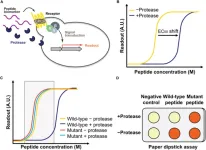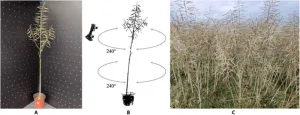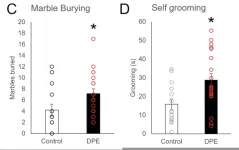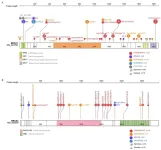(Press-News.org)
Biosensors—sensors that can detect biological samples—are powerful tools for understanding the function, composition, and structure of biochemical molecules. Biosensors are often applied for the detection of proteins and their subunits, called peptides, yielding a wide range of biomedical applications. In 2017, researchers from Columbia University in USA engineered a living yeast biosensor by rewiring pheromone-related signaling pathways used by yeast for mating. In the presence of the pheromone peptide, the G-protein coupled receptor (GPCR) could detect the peptide, triggering a cascade that would eventually activate a pigment called lycopene that gives tomatoes their red color. Thus, through a simple color change visible to the naked eye, the yeast biosensor could signal the presence of a particular peptide. However, this system lacked a peptide-cleaving catalytic enzyme called protease, the addition of which was anticipated to enhance its biosensing and discrimination abilities.
Accordingly, in a recent study made available online on 11 January 2023 and published in Volume 5 of the journal BioDesign Research on 15 March 2023, the group developed a new and improved dual version of their living yeast biosensor by incorporating co-expressed yeast proteases. The principal investigator of this study, Prof. Virginia W. Cornish, explains, “Our goal was to develop a dual biosensor. In the first part, the biosensor without the protease would detect the presence of all peptide variants. In the second part, the protease would be present. Only one variant of the protein would be cleaved by the protease so that a color change would be visible only for that specific variant. Here, we tried to develop a proof-of-concept for this sensing model.”
The development of this state-of-the-art biosensor was a long and technically challenging process. The researchers retained their original model, exploiting the mating pathways in yeast, and examined the dose–response curves of five fungal pheromone GPCRs, peptides, and proteases from Saccharomyces cerevisiae, Candida albicans, Schizosaccharomyces pombe, Schizosaccharomyces octosporus, and Schizosaccharomyces japonicus. Of these, the first two provided the most selective responses.
They then analyzed the peptides from these two species, i.e., S. cerevisiae and C. albicans, using alanine scanning—a technique that reveals how specific parts of a peptide contribute to its stability and function. Alanine scanning was performed with and without the protease. Accordingly, two peptide variants that could not be cleaved efficiently by the protease were identified: CaPep2A and CaPep2A13A. Meanwhile, their sister peptides—CaPep and CaPep13A, respectively—could be cleaved efficiently. Moreover, the color changes could be observed with the naked eye, without any need for specialized equipment.
These components were combined in a living yeast cell to develop the dual-phase biosensor. Proof-of-concept experiments revealed that the biosensor could not only detect the presence of CaPep/CaPep2A and CaPep13A/CaPep2A13A but also distinguish between them. Thus, as expected, the reintroduction of the protease enhanced the capabilities and potential applications of the original biosensor to a great extent.
According to Prof. Cornish and her team, this work is the first fundamental step towards developing a biosensor that could distinguish between a wide variety of peptides. “Synthetic biology is a step-by-step process. The framework developed in the current study can be improved through additional engineering via computational modeling and directed evolution. This will broaden the scope of biosensor’s detection capabilities,” she comments. “We could use these protease-containing biosensors in point-of-care diagnostic tools and drug testing, and even to develop a scalable communication language. The possibilities are endless,” she concludes, describing her vision for the future.
Overall, this study provides key insights into the manipulation of yeast mating components for developing synthetic biology tools. The findings are a testament to the exciting developments in the field of bioengineering and its potential to change our future.
###
Reference
Authors
Tea Crnković1, Benjamin J. Bokor2, Mead E. Lockwood3,and Virginia W. Cornish1,4
Affiliations
1Department of Chemistry, Columbia University, New York, NY 10027, USA.
2Department of Biological Sciences, Columbia University, New York, NY 10027, USA.
3School of General Studies, Columbia University, New York, NY 10027, USA.
4Department of Systems Biology, Columbia University, New York, NY 10027, USA.
END
Rapeseed or oilseed rape (Brassica napus L.) is an important crop cultivated worldwide for its oil-rich seeds. The rapeseed silique is an organ that plays a role in photosynthesis, sends developmental signals to maturing seeds, and provides a capsule that harbors the seeds. High-yield rapeseed varieties have both a high number and optimal morphology–the form and structure–of siliques. In this regard, rapeseed genotype and cultivation method directly influence the number of siliques that a plant produces. Thus, accurately quantifying silique development parameters is critical for predicting ...
NEW YORK, April 24, 2023—Columbia University today announced the establishment of the Stavros Niarchos Foundation (SNF) Center for Precision Psychiatry & Mental Health at Columbia University. The center will catalyze the scientific innovation and clinical implementation of precision medicine to advance the prevention, diagnosis, and treatment of mental illness. The center is being established with a $75 million grant from the Stavros Niarchos Foundation (SNF), an international philanthropic organization, as part of SNF’s Global Health Initiative (GHI).
The SNF Center is a joint effort of the Department of Psychiatry at Columbia University Vagelos College of Physicians ...
A new study from The University of Toledo suggests early exposure to a common class of insecticides called pyrethroids may increase the risk of autism and other developmental disorders, even at levels currently recognized as safe by federal regulators.
The findings, which come from a study of mice, were published today in the peer-reviewed journal PNAS Nexus.
Pyrethroids are some of the most widely used insecticides in the country, appearing in both consumer products and industrial preparations.
“If ...
With so many eHealth tools available, it can be challenging to select the best one for a specific health need. A recent study published in JMIR Human Factors provides valuable insights on how to choose quality eHealth tools in an evolving landscape of digital health technology. This study titled “Assessing the Quality and Impact of eHealth Tools: Systematic Literature Review and Narrative Synthesis” comprehensively examined how the quality and impact of eHealth tools are currently assessed.
Led by Dr Christine Jacob, a health tech researcher at the University of Applied Sciences and Arts Northwestern ...
SAN ANTONIO – April 25, 2023 – Southwest Research Institute (SwRI) has created a 3D simulation tool to test automated vehicles in virtual off-road environments modeled after real-world conditions. The research expands SwRI’s investment into software-in-the-loop solutions to test connected and automated vehicles (CAVs) in scenarios ranging from congested roadways to off-road terrain. A simulated environment, or a 3D “software loop,” supports evaluations of an infinite number of scenarios that would be cost-prohibitive to test in the real world.
The technology meets U.S. Department of Defense demands ...
A study of 72 mice mothers and their litters suggests a popular pesticide may cause neurodevelopmental disorders in humans. Previous studies have shown that nearly half of the risk for neurodevelopment disorders, including autism, is environmental, but few specific environmental causes have been clearly identified. James Burkett and colleagues exposed mice to low doses of pyrethroid pesticide deltamethrin during pregnancy and lactation. Pups of exposed mothers vocalized less compared to pups of unexposed mothers. ...
Homologous Recombination Deficiency (HRD) is a biomarker that predicts ovarian cancer treatment with PARP inhibitors or breast cancer treatment with first-line platinum-based chemotherapy. However, limited research is documented on platinum-based treatment prediction with HRD as a biomarker in ovarian cancer patients, especially in the Chinese population.
This first-ever China prospective cohort study, jointly conducted by BGI Genomics clinical researcher Dr. Shao Di and the Fudan University Shanghai Cancer Center team and published on the Journal of Ovarian ...
“Ted brings a wealth of knowledge and expertise in virology and human immune responses to viruses. He has played a key role in developing antiviral vaccines and furthering our understanding of important viruses transmitted by mosquitoes and ticks—arboviruses—and how neutralizing antibodies work against flaviviruses, such as Zika virus,” said Acting NIAID Director Hugh Auchincloss, M.D. “He is exceptionally well-suited to lead the VRC and its continued pursuit of innovative basic, translational and clinical discovery.”
Prior to his VRC appointment, Dr. Pierson served as a senior investigator and chief of NIAID’s Laboratory of ...
Brain Canada, Heart & Stroke, and the Canadian Stroke Consortium are thrilled to announce the recipients of the 2022 Stroke Clinical Research Catalyst Grants. The purpose of this program is to increase capacity for clinical stroke research within Canada, with an aim to reduce the burden of stroke, prevent recurrence, and improve patient outcomes through clinical research that will improve our understanding of stroke and advance stroke care.
“We are thrilled to be collaborating with two leading organizations ...
Gaithersburg, MD; April 25, 2023 - Cartesian Therapeutics, a fully integrated biopharmaceutical company pioneering RNA cell therapy for autoimmune diseases and cancer, today announced the appointment of three world-renowned scientists and engineers as charter members of the company’s Scientific Advisory Board (SAB): Prof. Jennifer Elisseeff (Johns Hopkins University), Prof. Andrés García (Georgia Institute of Technology), and Prof. David Mooney (Harvard University).
“These distinguished research leaders bring vast ...









